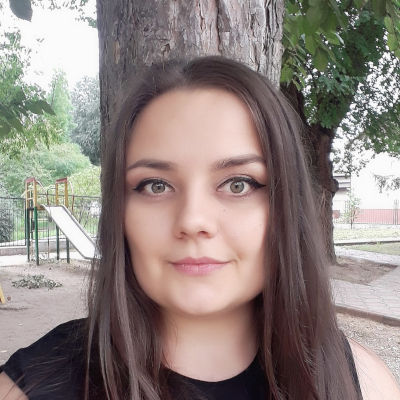The Mark III system presents a comprehensive suite of components designed for efficient and versatile construction. This innovative system offers a range of features that enhance the overall durability and functionality of structures. From insulated panels to structural supports, the Mark III system showcases an array of elements that work in harmony to deliver reliable and adaptable building solutions.
By understanding the capabilities and advantages of each element, we can unlock the full potential of this dynamic system, enabling us to create resilient and versatile structures that meet the demands of modern building practices.
MARK III System Components
The main components of the MARK III system are:
1 Studs.
2 Load bearing mastic.
3 Insulation panels:
- Flat panels.
- Corner panels (90°, 135°, three way corner panel).
- Top bridge pads.
4 Foam boards.
5 Triplex (secondary barrier).
6 Primary membrane:
- Membrane sheets.
- Corner pieces, dog-legs, end caps.
- Steel corners.
Studs
Studs are generally in AISI 1010 steel or, alternatively, stainless steel. Studs are only used for fitting and position adjustment in position of the insulation panels. See Figure 1.
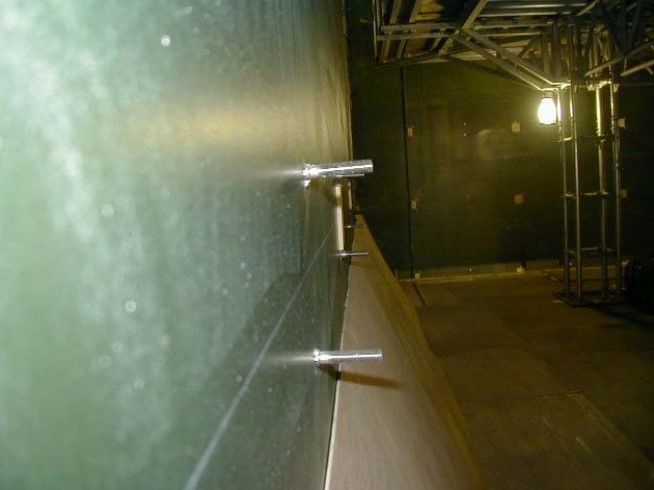
Load Bearing Mastic
The load bearing mastic is used both to provide support for the insulation panels and to bond them to the inner hull and, at the same time, to compensate for the irregularities of the inner hull. See Figure 2.
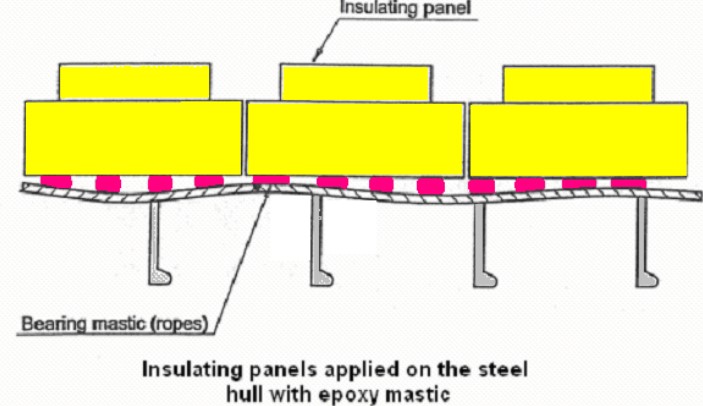
Mastic is an epoxy made of resin and hardener mixed in proportion specified by the supplier. Figure 3 shows the check of preparation of the mastic.
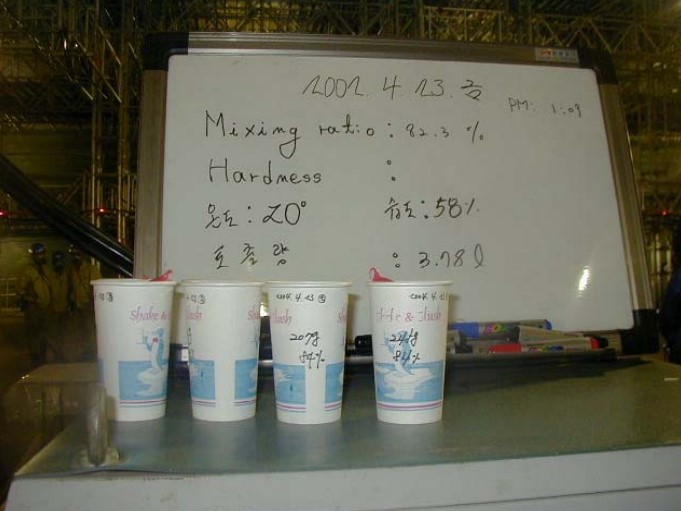
Figure 4 shows mastic samples.
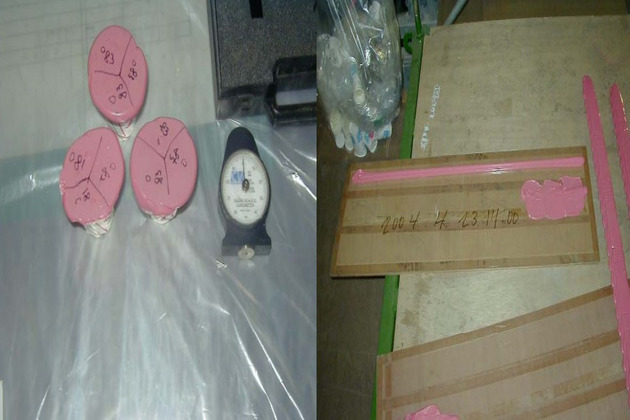
The main physical properties: of mastic are as follows:
1 VOLUMETRIC EXPANSION
After complete curing at 20 °C should not vary by more than 1 % of its initial volume.
2 COEFFICIENT OF THERMAL CONTRACTION of the cured mastic between – 30 °C and 50 °C should not exceed 60 10-6mm/mm/°C.
3 SHEARING PROPERTIES
From 20 ° C to – 25 °C Shearing strength > 12 MPa
4 TENSILE PROPERTIES
From 20 °C to – 25 °C
Modulus of Elasticity 1 000 < ET < 5 000 MPa
Elongation at rupture A % > 0,9 %
5 COMPRESSION PROPERTIES
Form 20 °C to – 25 °C
Compressive Modulus Ec > 1 000 MPa compressive strength at proportional limit Rc > 15 MPa
Pot life and curing time also play very important role s in quality of the resin.
Flat Panels
A typical flat wall panel is made mainly of:
1 The sandwich panel (lower part of the panel) includes:
- a plywood back;
- a rigid closed cell foam board;
- a secondary barrier layer.(See Figure 5.)
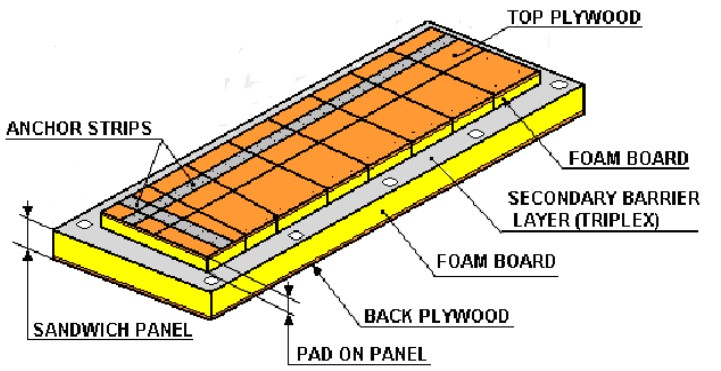
2 The “pad-on-panel” (upper part of the panel) includes:
- rigid closed cell foam blocks;
- a plywood top.
This layer is divided in modules with a square pitch cut of 340 m (normal case) in line with Key Characteristics of Membrane Tanks Systemsmembrane corrugations. This pad has machined areas for in lay of several stainless steel anchor strips. Anchor strips are attached with push through expansion rivets. Pads also have numerous “riv-nut” style metallic inserts, which are used to temporary attach tools necessary for handling the panels and for the erection of the insulation.(See Figure 6.)
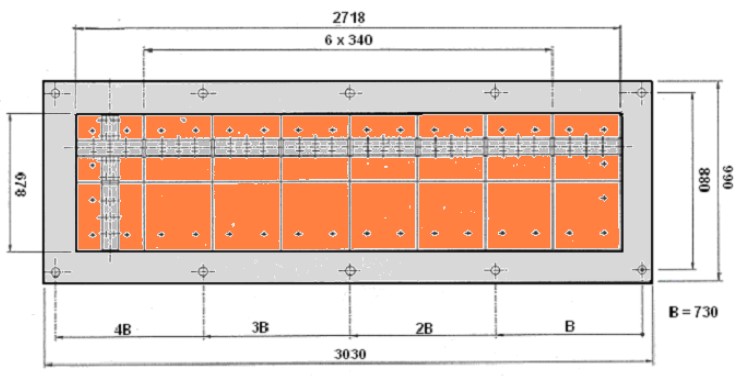
The different layers (plywood, foam boards, secondary barrier, foam blocks and top plywood) are affixed by proprietary adhesives.
Materials are the following:
1 PLYWOOD: birch plywood or combination of other woods may be used according to the location in the panel.
2 RIGID CLOSED CELL FOAM: reinforced polyurethane foam. Reinforcement is provided by fiberglass fiber in two directions, perpendicular to the expansion.
3 ADHESIVES: for panel manufacturing, polyurethane adhesives (two-components type) are used. Epoxy adhesives may be also used for some particular assemblies.
4 COMPOSITE MATERIAL FOR SECONDARY BARRIER triplex.
5 ANCHORING STRIPS: stainless steel AISI 304.
6 RIVETS securing the anchor strips on the top plywood: aluminum.
7 METALLIC INSERTS: carbon steel.
The critical parameters are:
- thickness;
- flatness;
- squareness.
The main dimensional tolerances are as follows:
- Sandwich panel thickness: +/- 1,0 mm.
- “Pad-on-panel” thickness: +/- 0,5 mm.
- Length: +/- 3 mm.
- Width: +/- 2 mm.
- Squareness: The difference between two diagonals not to exceed 1,0 mm by meter of length.
- Flatness: 2,0 mm by meter of length; the rise is measured with a ruler in all direction.
Figure 7 is the photograph of a number of flat panels ready to be installed.
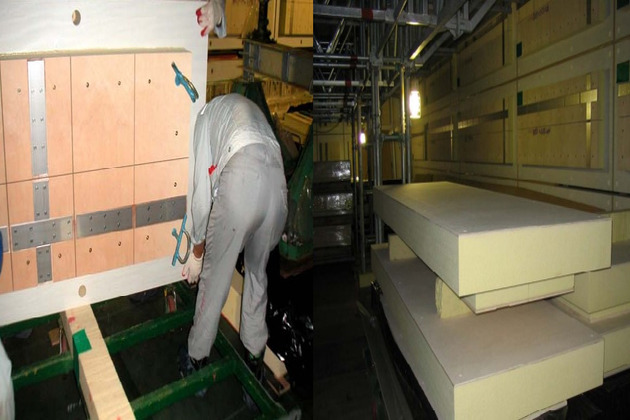
Figure 8 is the photograph after installation on the top of a tank.
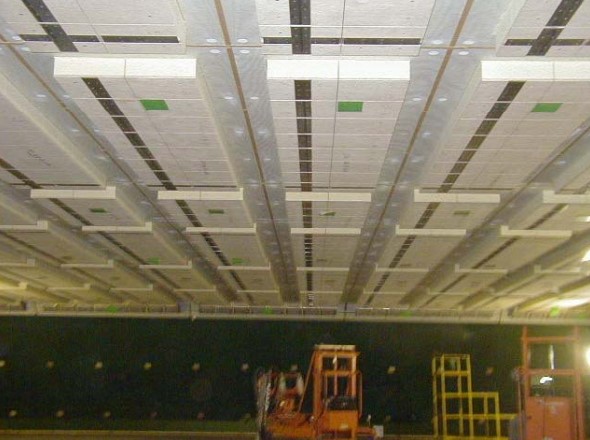
Corner Panels
A typical corner panel is made mainly of a basic panel (or single leg) including:
- the top and back plywood;
- the rigid closed foam block;
- the secondary barrier.
Two single legs are joined together through the hardwood key and the stainless corner. A joint exists between the two legs: it includes a plywood wedge and glass wool.
The continuity of the secondary barrier between the two legs is insured with a curved joint.
The hardwood keys are bonded on the secondary barrier. The stainless steel corners are fixed in the hardwood keys through studs and nuts. These studs are welded on the stainless steel corners during their prefabrication. The fixation of these corners should be such that they can slide on the hardwood keys (in operating condition).
Material of corner steel is AISI 304. Other materials are the same as for the flat panels. See Figures 9 and 10.
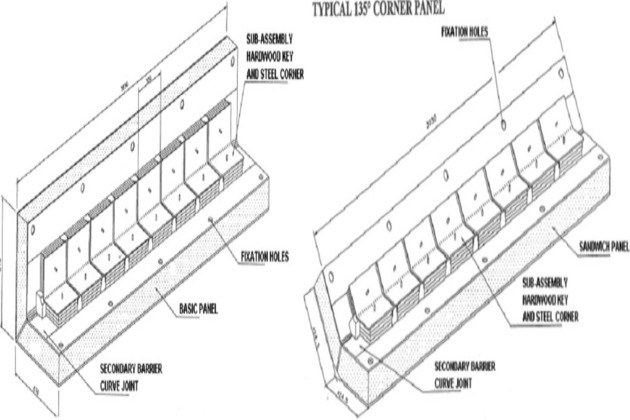
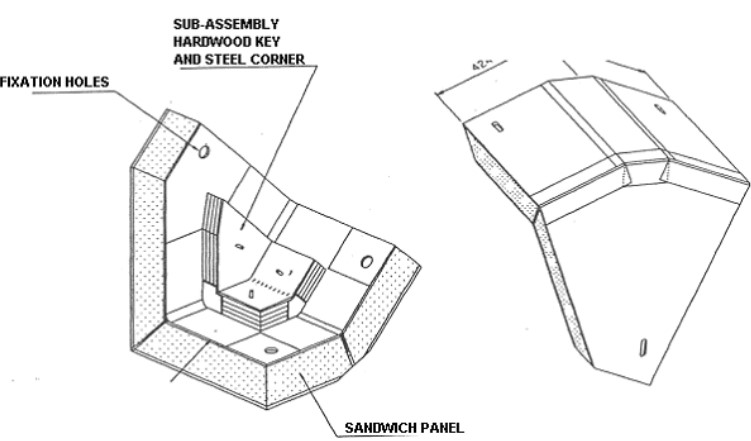
The dimension tolerances are:
- Total thickness: +/- 1 mm.
- Length: +/- 3 mm (on 3030 mm length).
- Single width: +/- 1 mm.
- Angle: -0,0°: +0,1°.
Top Bridge Pads
These final insulation blocks fill in the open spaces between pad-on-panel areas. These are installed after soft triplex has been glued in place, examined and leak tested.
A typical top bridge pad is made of:
- A plywood board, 12 mm thick at the top part.(See Figure 11.)
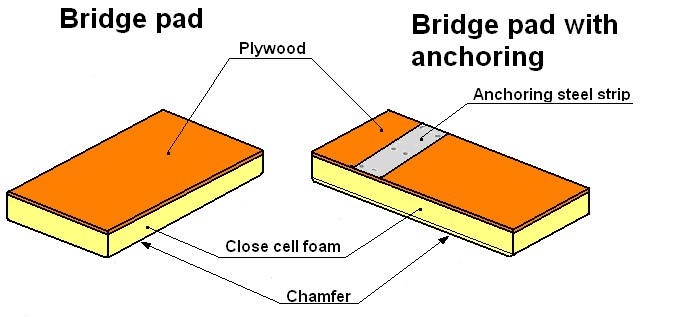
- A rigid closed cell foam block.(See Figure 12.)
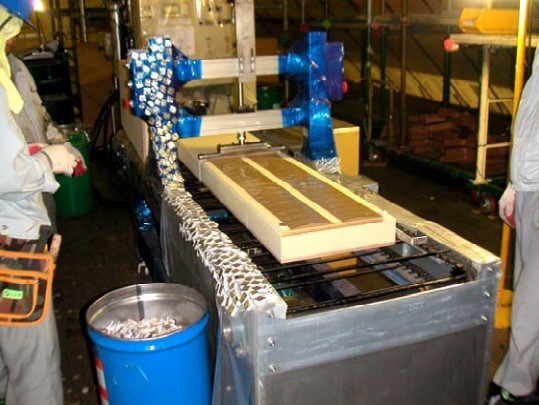
These materials are bonded together. If the location of the top bridge pad in the tank is in the way of a membrane sheet edge, anchor strips are fixed on the top plywood, similar to standard insulation panels. Top plywood is machined, anchor strips are fit and secured with push-in expanding aluminum rivets. Note that aluminum rivet location is kept out of weld attachment path for stainless steel corrugated panels.
The material is same as for the flat panels.
The dimension tolerances are:
- Total thickness: +/- 0,5 mm.
- Length and width: +/- 1 mm.
- Squareness: the difference between two diagonals must be less than 1 mm.
- Flatness the rise is measured with a ruler along the diagonals and is to be less than 1,0 mm for the length of about 500 mm.
Reinforced Polyurethane Foam Boards
The reinforced polyurethane foam is produced in a continuous run, on a laminator, using high-density polyurethane foam together with fiberglass fiber continuous strand mat to increase the resistance at cryogenic temperature to thermal and mechanical stresses induced by the ship’s deflection at sea.
After foaming and temperature stabilization the boards are planed and cut into requested dimensions.
1) MATERIAL USED
High-density polyurethane foam liquid components.
Continuous strand mat.
2) MAIN CHARACTERISTICS OF THE PRODUCT
The finished boards are cut from the produced raw board after curing (2 weeks). The board thickness corresponds to the foam expansion direction and shall be at least 160 mm. The necessity to produce raw foam board of regular shape is a crucial parameter to avoid discarding excessive amount of raw materials.
The thickness may vary with the contract boil off of each vessel. Note that a lower boil off (thicker insulation panel) may be obtained at the expense of the cargo volume. Present accepted trade off value for the boil-off is 0,15 % per day.
3) APPARENT DENSITY AND COMPRESSIVE PROPERTIES
The density should be uniform within the same board with a maximum difference not exceeding 8 kg/m3 (measurement performed on the samples for compressive test).
The apparent density “d” at 20 °C should be (average on five specimens):
The compressive requirement is that the compressive strength and modulus are determined at 20 °C in the direction of the foam expansion (average on five test pieces):
- compressive strength Rc > 1,2 MPa;
- compressive modulus Ec > 47 MPa;
- compressive strength on individual test piece Rc > 1,0 MPa.
4) TENSILE PROPERTIES AT 20 °C AND – 170 °C
The requirement is in the X and Y directions:
a) 20 °C ( average on five test pieces):
- Tensile strength RT > 2,4 MPa.
- Young’s modulus 110 < ET < 150 MPa.
- Tensile strength on individual piece RT > 2,1 MPa.
b) 170 °C (or –196 °C) ( average on five test pieces) :
- Tensile strength R’T > 2,7 MPa.
- Young’s modulus 190 < E’T < 235 MPa.
- Tensile strength on individual piece R’T > 2,4 MPa.
The lower limit of Young’s modulus at 20 °C and – 170 °C are given for reference only. Values below these limits are acceptable, provided all the other mechanical properties of this specification are met.
5) THERMAL CONTRACTION COEFFICIENT BETWEEN 20 °C AND MINUS 196 °C
The tests are performed in the main three directions of the panels:
- X and Y directions XY < 25 10-6mm/mm/°C.
- Z direction Z < 71 10-6mm/mm/°C.
6) SHEARING PROPERTIES AT AMBIENT TEMPERATURE AND AT MINUS 100 °C
The test is performed on five test pieces in each direction:
a) At -100°C the requirements are:
- X and Y directions Rs > 1,00 MPa.
- Z direction Rs > 1,40 MPa.
On individual test piece Rs > 0,90 MPa in X and Y direction, Rs > 1,20 MPa in Z direction.
b) At 20°C the requirements are:
- X and Y directions Rs > 0,90 MPa.
- Z direction Rs > 1,20 MPa.
On individual test piece Rs > 0,80 MPa in X and Y direction, Rs > 1,00 MPa in Z direction.
7) CLOSED CELL CONTENT
Closed cell content is to be 94 %.
8) DETERMINATION OF THE PERMEABILITY TO MOISTURE
The test conditions correspond to 20 °C and to 0 °C through 85 % relative humidity gradient.
Permeability to moisture is to be < 4,0 g/m2/h.
9) THERMAL CONDUCTIVITY COEFFICIENT
The thermal conductivity curve between -160 °C and +20 °C is determined for the approval procedure. This test is performed on at least 4-month-old foam.
10) QUALITY CONTROL
During fabrication, a strict QC/QA has to be applied. Particular attention is to be paid to the following two points:
- The glass mat should be stabilized during a sufficient time in temperature to avoid any water condensation, humidity absorption. During foaming process; the glass mat is to be visually examined to avoid any defect such as thick fibers, glass heap, water spot, sizing agent spot, foreign body, dirt, hole or lack of glass. Any of these defects may lead to defect and in particular to internal delaminations.
- UT check can be carried out to detect any internal defects.
Secondary Barrier Material: Triplex
There are two kinds of secondary barrier:
- The rigid barrier, which is built-in the insulation panel between the two foam boards.
- The flexible barrier, bonded between flat panels, flat panels and corner panels and between corner panels.
The Rigid Secondary Barrier
The rigid composite material used for rigid secondary barrier must:
- be perfectly tight to liquid methane;
- resist to mechanical stresses due to thermal contraction and ship motion when Response of Insulation Materials to Heatthe insulation system is in service at very low temperature, close to -100 °C in normal service and -163 °C in emergency case;
- present a proper chemical compatibility with liquid methane, with sea water, with ammonia-nitrogen mixture (25 % NH3, 75 % N2) with all adhesive products used for the assembling of insulation system, mainly epoxy adhesives and with the blowing agent used for the foam production.
The product is generally made of a thin aluminum foil inserted and bonded in between two impregnated glass clothes.
The thickness of the aluminum foil has to be 70 +/- 10 %.
1) CHEMICAL COMPATIBILITY OF THE PRODUCT
The raw materials used to manufacture the product shall be compatible with:
- Liquid methane;
- Sea water;
- N2 /NH3 mixture:
- Adhesives (PU or epoxy).
2) MECHANICAL CHARACTERISTICS
- Shearing strength:
- Perpendicular tensile strength:
- Peeling stress strength:
- Tensile strength in both direction (lengthwise and crosswise):
- Elasticity modulus in both direction (lengthwise and crosswise):
At 20 °C > 3,5 MPa
At -170 °C > 3,5 MPa
At 20 °C > 3,0 MPa
At -170 °C > 3,0 MPa
At 20 °C > 34 N per 2,5 cm
At -170 °C > 34 N per 2,5 cm
At 20 °C > 88 000 N/m
At -170 °C > 190 000 N/m
At 20 °C
3 000 MPa < modulus < 26 000 MPa
At -170 °C
13 000 MPa < modulus < 26 000 MPa
3) THERMAL CONTRACTION COEFFICIENT
The average coefficient from 20 °C down to -196 °C must be:
4) DIMENSIONAL CHARACTERISTICS
The product will be delivered in sheet with following dimension:
- Length: > 3 050 mm
- Width: > 1 010 mm
The Flexible Secondary Barrier
The flexible secondary barrier must:
- be perfectly tight to liquid methane;
- resist to mechanical stresses due to thermal contraction and ship motion when the insulation system is in service at very low temperature, close to -100 °C in normal service and -163 °C in emergency case;
- present a proper chemical compatibility with liquid methane, with sea water, with ammonia-nitrogen mixture (25 % NH3, 75 % N2) with all adhesive products used for the assembling of insulation system, mainly PU and epoxy adhesives.
The product is generally made of a thin aluminum foil inserted and bonded in between two impregnated glass clothes. The thickness of the aluminum foil has to be 70 +/- 10 %.
Read also: Aluminum Welding Techniques: Advanced Methods
Figure 13 shows a roll of flexible triplex.
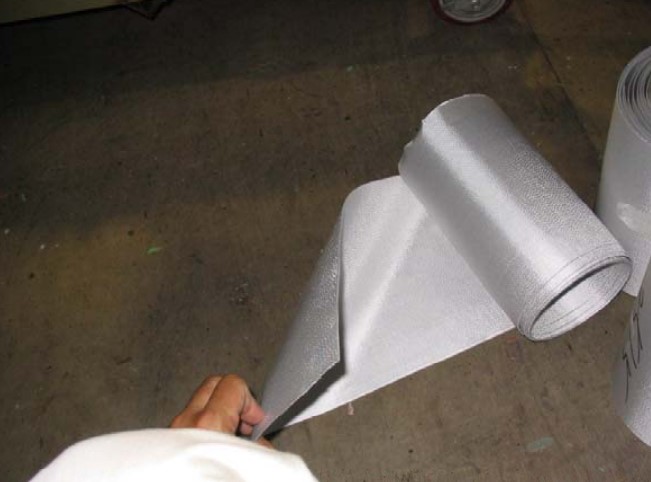
1) CHEMICAL COMPATIBILITY OF THE PRODUCT
The raw materials used to manufacture the product shall be compatible with:
- Liquid methane.
- Sea water.
- N2 /NH3 mixture.
- Adhesives (epoxy).
2) MECHANICAL CHARACTERISTICS
- Shearing strength:
- Perpendicular tensile strength:
- Peeling stress strength:
- Tensile strength in both direction:
At 20 °C > 3,5 MPa
At -170 °C > 3,5 MPa
At 20 °C > 3,0 MPa
At -170 °C > 3,0 MPa
At 20 °C > 34 N per 2,5 cm
At -170 °C > 34 N per 2,5 cm
a) Warp:
at 20 °C > 88 000 N/m
at -170 °C > 190 000 N/m
b) Woof:
at 20 °C > 88 000 N/m
at -170 °C > 190 000 N/m
3) DIMENSIONAL CHARACTERISTICS
In general, the product will be delivered in rolls with following dimension:
- Length: > 30 m.
- Width: > 1 m or less.
Primary Membrane Components
The membrane, which forms the primary barrier of the cargo tanks, is made of standard components including:
- Corrugated sheets, which are fitted on the vertical walls or horizontal faces of the tank (see Figure 14).
- Corrugated sheets, different from the preceding ones (pitch), which are fitted on the chamfered sides.
- Entrant angle pieces and re-entrant angle pieces (see Figure 15).
- Bent pieces (dog leg) (see Figure 16).
- Sealing caps (see Figure 17).
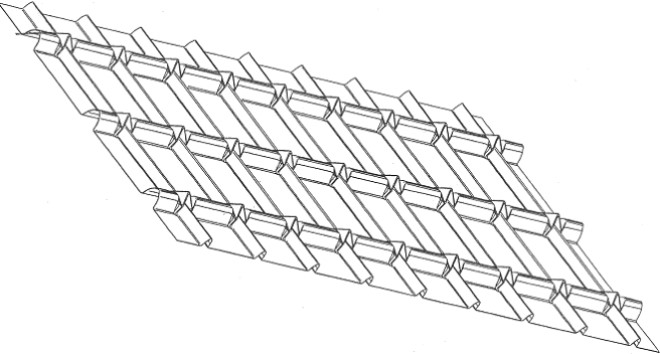
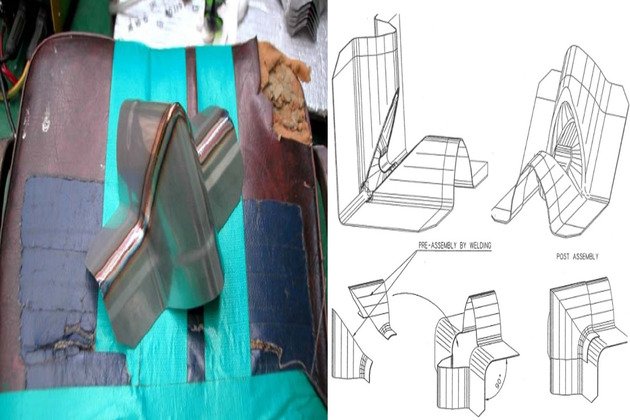
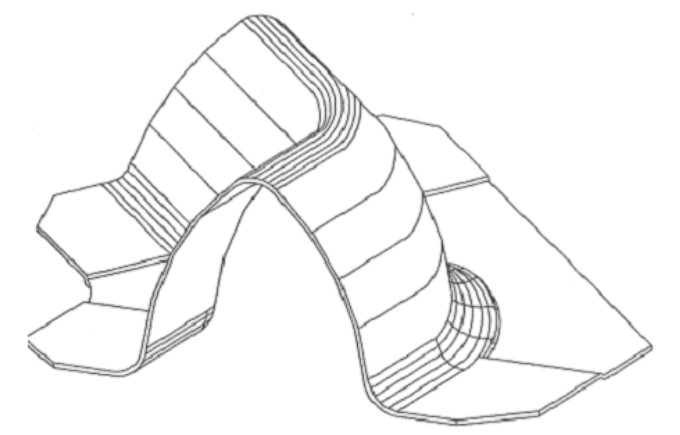
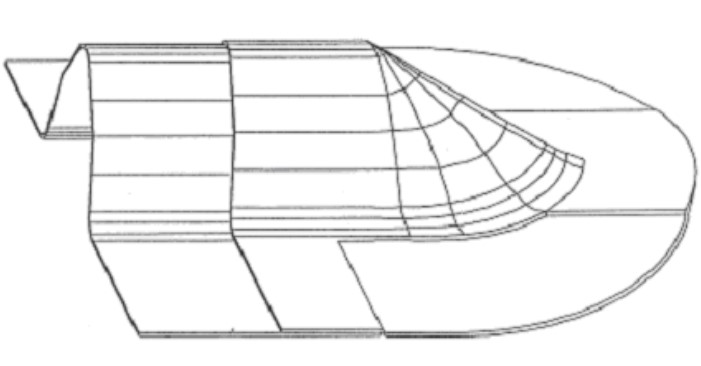
All these components are manufactured from 1,2 mm thick stainless steel 304L sheets.
Protective wrap sheeting is kept on throughout the shaping operations and until pieces are fit in the tanks.
Figure 18 is photograph of pallets of membrane sheet ready to be installed.
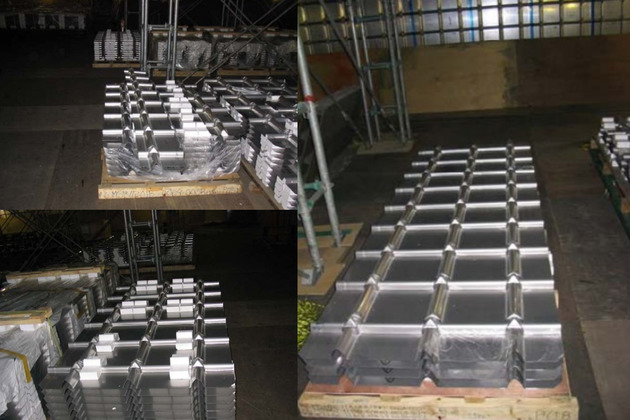
Corrugations and knots are cold formed by pure folding without heat, with no stamping effect using tooling specially designed for this purpose.
The tooling for forming the corrugation has been designed in order to obtain corrugations of constant length and separation distance of expanded sheet regardless of the behavior of the sheet after shaping (see Figure 19).
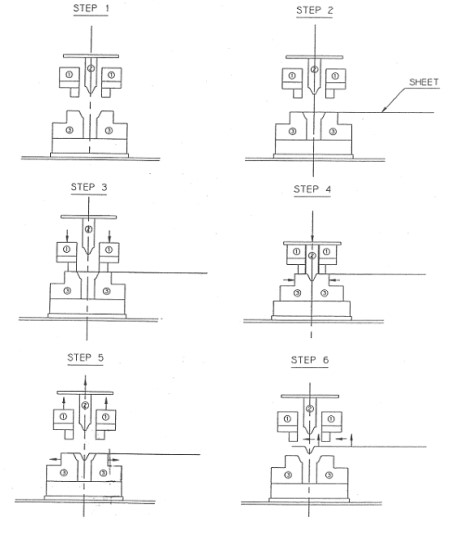
This constant length of expanded sheet provides satisfactory fitting and proper overlapping, when overlapping is required, when the sheets are fitted in the tank and tacked before welding.
During the operations for fabricating the standard primary barrier components, very special attention must be given to the cleanliness of the sheets to be used and to that of the tooling for final shaping.
1) CORRUGATED SHEETS
There are sheets for vertical and horizontal sides (see Figure 14).
These sheets bear two mutually perpendicular sets of non continuous, pointed arch-shaped corrugation, which cross over each other and form at their points of intersection, a geometric figure called a knot.
The other set is composed of small corrugations.
After the corrugations are formed, these sheets are joggled over a part of their perimeter according to their position.
The largest sheets have three large corrugations and nine small corrugations.
Small corrugation pitch: 340 mm.
2) SHEETS ON CHAMFERED SIDES
Theses sheets bear two sets of mutually perpendicular corrugations (large ones and small ones) with different pitches.
Small corrugation pitch: 480 mm
After the corrugations are formed, also these sheets are joggled over a part of their perimeter according to their position.
The largest sheets for the chamfered sides have three large corrugations and twelve small corrugations.
3) FORMING OF THE CORRUGATIONS OF A SHEET
The operations for forming the corrugations of a sheet are generally preceded by the precutting of one of the edges of the sheet crosswise in order to obtain suitable perpendicularity of this edge with respect to the two long edges.
The sheet shaping operations involve:
- Forming of the large corrugation with a triangular profile.
- Forming of the small corrugation and the knots with their final profile.
- Final shaping of the portion of triangular large corrugation between the knots in order to obtain the final corrugation profile.
- Joggling the sheet over a portion of its perimeter.
4) DIMENSIONS AND TOLERANCES AFTER SHAPING
- OVERALL FLATNESS TOLERANCE.
- DIMENSIONAL TOLERANCES.
This check is carried out by means of one-meter long ruler, which is moved along astride the tops of the corrugations, the sheet being laid on a flat table.
The maximum distance between the tops of the corrugations and the ruler is 1,5 mm.
For tolerances on position of corrugations adjacent to edges reference is to be made to Figure 21.
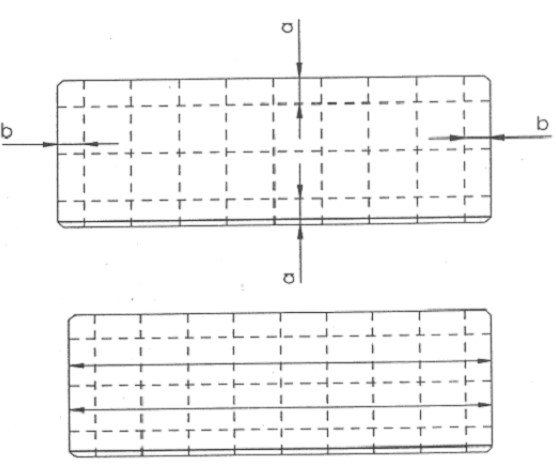
The tolerance on the distance between the centerline of the edge corrugations and the closest parallel edge is 2 mm. This tolerance is measured by the difference between the overall length of the sheet measured and the above measured distances.
The tolerance of the sheet dimension is function of the number of corrugations on the sheet.
Sheet having:
- 3 small corrugations +/- 2 mm.
- 6 small corrugations +/- 3 mm.
- 9 small corrugations +/- 4 mm.
- 12 small corrugations +/- 6 mm.
- TOLERANCE ON JOGGLES
- BURRS ON EDGES
The tolerance on the position of the joggles with respect to the edge of the sheet is 0 /- 1 mm.
Generally the completed sheet should have no burr on edges.
5) ANGLE PIECES
The angle pieces provide the junction of the sheets of two contiguous sides along the corresponding edge. They are divided in two categories:
- Entrant angle pieces.
- Re-entrant angle pieces.
The entrant angle pieces (see Figure 15) are formed from corrugation folded with a fold whose geometry is particularly special (90°; 135°; 108,26° and 161,34° for tank no.1).
The re-entrant angle pieces (see Figure 16) have a piece welded and are of the 90° type only.
The following distinctions are made:
- Large corrugation / large corrugation pieces.
- Small corrugation / small corrugation pieces.
- Large corrugation / small corrugation pieces.
The angle pieces are joggled along the leg edges parallel to the fold so that these edges will overlap the sheet edges.
- DETAILS OF ANGLE PIECE FABRICATION OPERATIONS
In each case the initial piece is composed of a portion of flat sheet whose dimensions correspond to those of the expanded completed piece or are slightly greater. The angle piece, in the latter case, is brought to the final dimensions as fabrication is nearing completion.
- Entrant angle pieces.
The operations to be carried out are in principle:
- folding to an angle on about 105° for the cut blanks;
- forming of the two corrugations (large corrugations) and the elastic central part, the angle of the dihedral being maintained at all times greater than the theoretical angle (105° or 150°). This operation is completed by re-forming the large corrugation into small corrugation for certain angle pieces;
- reshaping of small corrugation for certain angle pieces;
- application of press in the elastic central part to realize the theoretical angle;
- correction of the fold of the angle pieces;
- bringing the pieces to the desired dimensions followed by careful removal ofburrs;
- joggling.
- 90° re-entrant angle pieces.
The operations to be carried out are in principle:
- final forming of the corrugation on the flat sheet to the joggle profile;
- cutting out of the corrugation around the middle of the fold line;
- folding of the angle piece 90°, the folding radius being about 10 mm;
- making of a patch plate whose shape is designed to cover over the opening made in the angle piece. This patch plate is composed of two parts pre-welded together;
- careful removal of the burrs.
- DIMENSIONS AND TOLERANCE OF ANGLE PIECES.
- Geometric tolerances – Tolerance on straightness of fold.
- Angular tolerance
- Dimensional tolerances – Tolerance on position of corrugation on each leg.
- Tolerance of fold and length of each leg of the dihedral.
- Tolerance on joggled edges.
- Edge burrs.
The piece being laid on its fold on a table, the deflection measured along the fold must be less than 1 mm.
Theoretical angle +/- 1°.
The tolerance on the distance of the center line of the corrugation on each leg to the parallel edge of the angle piece is +/- 2 mm.
The tolerance allowed on the length of the fold and the length of the leg of the dihedral is +/- 2 mm.
The tolerance on the width of the joggled edges is +/- 1 mm.
Generally no burrs allowed.
6) DOG LEGS
The dog-legs provide the union of the tight transverse bulkheads corrugations in the vicinity of the chamfered sides (see Figure 16). This union has a curved shape, the curvature of the corrugation being 135° in the plane of the piece.
The dog-legs are divided into four categories:
- Large corrugation/large corrugation piece angled to the left and the symmetrical pieces angled to the right.
- Large corrugation/small corrugation pieces angled to the left and symmetrical pieces angled to the right.
The dog-legs are slightly joggled along their edges.
Fabrication of dog legs
The dog-legs are fabricated by means of stampers of appropriate shape and dimensions.
7) SEALING CAPS
The sealing caps are designed to close off the corrugation of the sheets (see Figure 17).
Two kinds of sealing cap are considered:
- One is shape with a degressive profile.
- The other one is a flat portion of sheet having substantially the same profile as that of the corrugation to be sealed off and is obtained by cutting of flat sheet.
Stainless Steel Corners
The stainless steel, 304L, corners are fixed on the corner panels. They are used to weld the first membrane sheet and the angle pieces along the edges of the tank.
Read also: Welding of Stainless Steel for LNG Applications
The stainless steel corners include two main types: the two-way corners and the three ways-corners. For each type various angles may exist.
Reinforced by two stiffeners welded on the external side, the two-way corners are obtained by cold bending of thick stainless steel sheet, then threaded studs are welded. See Figures 22.
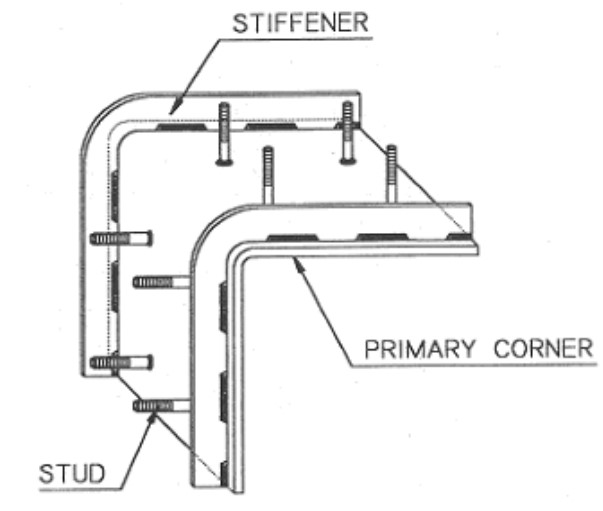
Figure 23 shows two-ways corners with the attached insulation ready to be installed.
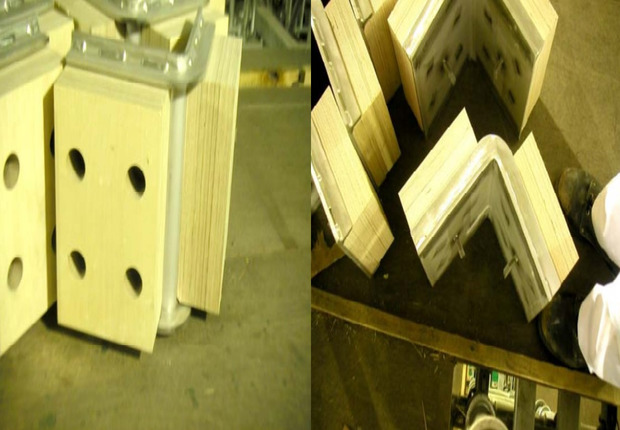
Figure 24 shows a series of corners after installation.
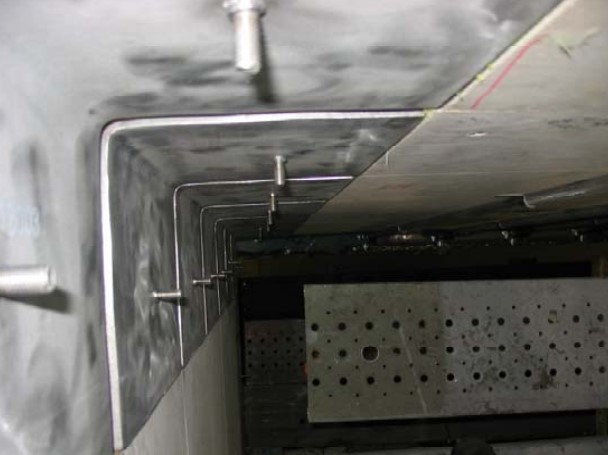
The three way corner is obtained by addition of a third wing to a two way corner. The three way corners are also completed by welded threaded studs but do not include any stiffener. See Figure 25.
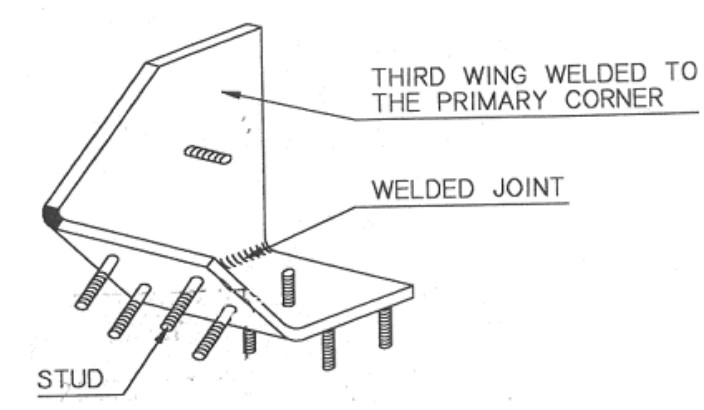
- MATERIALS
- DIMENSIONS AND TOLERANCES
The steel plates used for the fabrication of steel corners and associated stiffeners are thick stainless steel. The studs, nuts and washers are also stainless steel made.
The basic tolerances are as follows:
- Thickness +/- 0,5 mm.
- Thickness variation on each wing 0,4 mm max.
- Corner breadth +/- 1 mm.
- Wing height 0 /- 2 mm.
- Angular tolerance +/- 0,15o.
- Stiffener position +/- 1 mm.
- Stud position +/- 0,5 mm.
- Bending radius +/- 1 mm.
The welding procedures for the stiffeners and the studs are to be certified.

